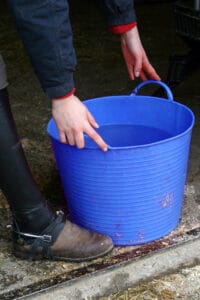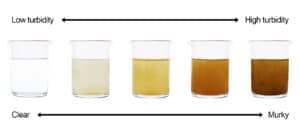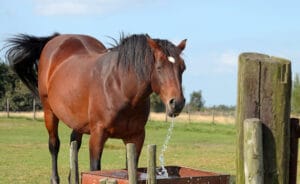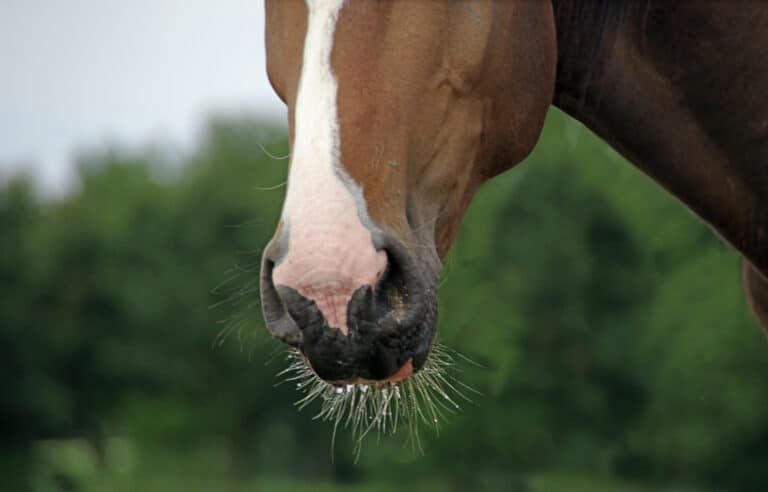In the first of a two part special feature, DAVID NASH, Director of Nutrition Technology at Kentucky Equine Research, talks water quality and its role in determining both your horse’s intake and health.
The most important and most limiting nutrient in the horse’s diet is one rarely thought about: water. Often overlooked in discussions involving equine nutrition, water is the first limiting nutrient for any horse.
An adult horse’s body is composed of roughly 70 per cent water, equating to approximately 360 litres for the average 500 kilogram horse. Foals’ bodies have even higher water content, roughly 80 per cent on a weight-to-weight basis.
The amount of water a horse requires daily is determined by the magnitude of water losses from its body. These losses occur through faeces, urine, respiratory gases, and sweat, and, in the case of lactating mares, milk. Water requirements are also dependent on factors such as age, environment, temperature, humidity, exercise intensity and duration, basal fitness level, and type and quality of feed consumed. In the case of lactating mares, stages of lactation also play a large role in water requirements. A general guide for water consumption for a mature idle horse is 5 litres per 100 kilograms body weight.
Table 1: Average water intake for 500kg horse.

Table 1 depicts ranges of water intake for various categories of horses. You’ll notice that environmental temperature has a dramatic effect on water consumption. When temperatures rise, intakes rise – but in cooler weather voluntary intake drops and this can lead to an increased risk of impaction colic. The addition of salt to the diet will drive the thirst response and increase the horse’s desire to consume water.
Water temperature also plays a role in voluntary consumption. Around 10 to 18°C seems to be the sweet spot for encouraging consumption. Studies showed a drop in consumption of 38 to 41per cent when horses were offered near freezing water. In parts of the world where temperatures sometimes drop below freezing, farm managers install heated waterers or troughs to encourage consumption. Aside from temperature, freshness, purity and palatability are also factors influencing consumption.
As a general rule, water intake is proportional to dry matter intake, but the composition and digestibility of the feed is also a factor. Horses consuming all-hay high fibre diets drink more water than horses fed a grain based, higher carbohydrate diet coupled with hay. Diets higher in fibre, protein, sodium and potassium can increase water intake, and subsequently result in increased urinary excretion.

Monitoring horses’ water intake on pastures can often be misleading, especially when pastures are lush and green. Green pastures can be 65 to 80 per cent water, meaning many horses consume much of their water requirement simply by eating pasture. A study of mares showed a pasture intake of 61 to 75 kilograms for pregnant mares, and 39.5 kilograms for non-pregnant mares. The pasture was measured at 79.6 per cent moisture which was an equivalent of 31 to 60 kilograms of fluid, which is very close to a horse’s requirements. Table 2 will help you estimate your horse’s water consumption from their diet.
Table 2: Moisture content of typical feed ingredients.

The drinking behaviour of horses is episodic and circadian in nature. These episodes are modified by the water source, quality, temperature, and availability, and the age of the horse. Table 3 shows the results of studies measuring episodes of drinking and total time drinking per day. Given the choice, horses will choose buckets over self-waterers 98 per cent of the time, with one study showing that horses prefer blue buckets.
Table 3: Drinking frequency of horses in different physiological states.

Water quality plays a major role in determining both intake and the horse’s health. For health and productivity, it’s imperative that good quality water is offered, and that water quality is managed and monitored.
Measuring water quality can be broken into two distinct parameters: physical and chemical/biological. Physical parameters to monitor can include odour, colour, temperature, turbidity and total dissolved solids (TDS). Chemical and biological parameters include hardness, pH, minerals, protozoa, algae, bacteria, and chemical residues.
As we mentioned, water quality is an important driver in water intake. Odours from organic material, minerals such as iron and sulphur, can negatively affect palatability. Temperatures below 5°C and over 30°C have shown significantly reduced intake, but colour seems to be more of an issue to humans than to horses.
Turbidity is an optical determination of water clarity. Turbid water will appear cloudy, murky, or otherwise coloured, which is caused by suspended sediment such as silt, clay and inorganic materials, or organic matter such as algae, plankton and decaying material. Turbidity measurements are often used as an indicator of water quality based on clarity and estimated total suspended solids (TSS) in the water.
Image 1:

Total dissolved solids (TDS) are the combination of all inorganic and organic substances present in a liquid in molecular, ionised, or microgranular suspended form. The safe upper limit of TDS for horses is 6,500 milligrams per litre (mg/l). Water below 1,500 mg/l TDS is considered fresh water. Water greater than 5,000 mg/l TDS is considered to be saline. To give you a guide, most municipal mains drinking water is less than 500 mg/l TDS.
The ability of water to conduct an electric current is sometimes referred to as hardness or salinity. Salts or other chemicals dissolved in water can break down into positively and negatively charged ions, which conduct electricity. So the electrical conductivity of water depends on the concentration of ions.
Table 4

Total Suspended Solids (TSS) are particles larger than two microns found in the water column. Anything smaller than two microns (the average filter size) is considered a dissolved solid. Most suspended solids are made of inorganic materials, though bacteria and algae can also contribute to TSS concentration.
With respect to pH, water for domestic and stock use should be in the range pH 6.5 to 8.5. If the pH is highly acidic (less than 5.5), acidosis and reduced feed intake may occur. Highly alkaline water (over 9) may cause digestive upsets and diarrhoea, with lower feed conversion efficiency.
Biologicals such as protozoa, algae and bacteria are quite important to monitor to ensure they are not affecting your horse’s water quality. Protozoa are single cell organisms such as cryptosporidium and giardia which, if your water is from dams, creeks or rivers can be present after heavy rainfall. Symptoms for both humans and horses include diarrhoea, fever, and possible dehydration.
There are many types of algae present in the water system and they generally bloom due to eutrophication. One of the more notable species is blue green algae (cyanobacteria), which can cause muscle tremors, respiratory distress, seizures, diarrhoea, or death if enough is consumed. Other algae produce toxins that affect the liver, causing either sudden death, or a more delayed death after signs of acute liver failure occur. Photosensitization, a skin condition affecting non-pigmented areas of skin, can occur in animals that survive the acute stages of liver damage.
Bacteria are measured in total coliform units. Salmonella and E coli can be a major issue for horses consuming poor quality water, resulting in severe health and reproductive problems.
Water testing is not overly expensive and gives a snapshot of your water quality, which when added to pasture testing, nutritional feed analysis, and veterinary diagnostics, can present a more accurate assessment of your horse’s health and assist in pinpointing the cause of a health issue.
If you do test your water, choose an accredited laboratory able to give you advice and determine what the results mean for your situation. If you test periodically, at the start of each season for example, use the same laboratory to ensure consistency. Take advice on how and where to take samples, and how to store them before delivering them to the laboratory. It is not as simple as just turning on the tap.

If you have generally good quality water, and a filtration system that reduces the organic matter that feeds algae and bacteria, water quality management can be as easy as regularly cleaning and maintaining your tanks and troughs. For more substantial treatment options, ozone can be used to disinfect the water, killing bacteria, viruses, and protozoa, as well as reducing odours that may affect palatability and water intake.
Ultra Violet light systems that disrupt bacteria’s ability to replicate are often used. Water softeners can increase palatability by removing minerals such as calcium, iron and manganese through ion exchange, and chlorine at low levels is often used to disinfect the water.
A common product that helps with trough hygiene is copper sulphate, or products containing it. However, don’t overdose with this as it can lead to high copper levels in the water. Over consumption of copper in the total diet can affect ratio relationships with zinc and other minerals, leading to deficiencies and issues with growth, development, general health and immunity. As a guide use only one sixteenth of a teaspoon of copper sulfate in a 150-200 litre trough.
Don’t miss our next issue when David will be back with a fascinating article on pasture quality. And for more information on water quality, please visit ker.com, or talk to your local agronomist, or a Department of Agriculture field officer.



